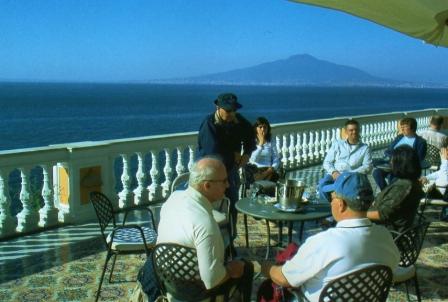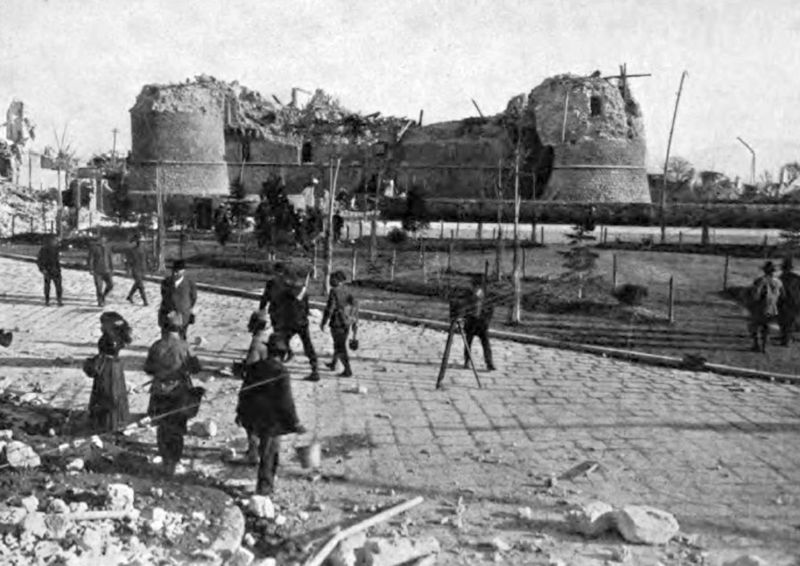
Living On The Edge
by Thomas Frascella
As we have seen in the previous articles regarding our Southern Italian Heritage, the regionís geographic location has presented both positive and negative opportunities for its people throughout the centuries. The regionís location in the center of the Mediterranean has allowed it from time to time to prosper from trade and to develop from exposure to some of the worldís oldest and greatest ancient cultures. However, its location and prosperity have also made it desirable real estate bringing armies of conquest and foreign domination. Trade has also brought with it exposure to many foreign diseases. The area experienced the earliest outbreaks of the Black plague in Europe as the plague followed the ancient trade routes. Many Wars have also been fought on its soil by both foreign powers seeking territorial expansion and domestic armies seeking consolidation of local power. The ravages of so many wars have severely decimated the population through the ages and destroyed many of the regions greatest cultural monuments.
In addition to the above, the region lies where the African continental plate collides and is grinding below, the Eurasian continental plate making the region one of the most geologically active in the world. The area is frequently subject to both violent earthquakes and volcanic activity. Despite all of the above the people of the region have demonstrated a remarkable resilience and a zest for life that is unequalled. With limited resources and with little external help after each seemingly unbearable event some survive to rebuild and start again.
Mount Vesuvius
Created by the collision of the continental plates the region between Mt. Vesuvius and Mt. Vulture began their volcanic histories over 600,000 years ago. Mt. Vulture is considered extinct having not erupted in over 40,000 years. The last massive volcanic eruption of Mt. Vulture created the caldera depressions that now lie beneath many of the areas lakes of the region. While Mt. Vulture has gone inactive Mt. Vesuvius has not. Mt. Vesuviusí mountain and caldera started to form roughly 25,000 years ago. One of the most violent eruptions of Vesuvius occurred about 3,500 years ago and is called the Avellino eruption. The eruption was violent enough to kill Bronze Age villagers as far away as present Avellino. Evidence of the remains of the villages, cattle and villagers buried in the volcanic ash of that eruption have recently been discovered by archeologist working in the area. Since the famous eruption of Vesuvius in 79 AD in which Pompeii and Herculaneum were destroyed, Vesuvius has erupted about three dozen times. Vesuvius seems to have had two distinct active periods the first started in 79 AD with eruptions also recorded in 203, 787,968, 991,999,1007and 1036. Vesuvius was then quiet for a period of several hundred years but entered a second active phase with eruptions recorded in 1631 ,1660, 1682, 1698,1707,1737,1760, 1767, 1779,1794, 1822,1834, 1839,1850, 1855, 1861,1868,1872, 1906, 1926, 1929 and most recently 1944.

Today even with the history of eruptions recorded above over three million people live within fifty miles of Mt. Vesuvius. Of that number around one and a half million live within ten miles of the volcano. Experts consider the fifty mile radius to be within the zone of substantial risk in the event of a major eruption. San Fele and the Vulture region are at the outer edge of the Vesuvius danger zone. Within the zone people are at risk for direct impact from materials expelled from the eruption, lava, rocks, hot gases and ash, they are also at risk from building collapse due to the earth tremors that would follow. Records indicate that in the past two thousand years, between 100,000 and 150,000 people have died due to Vesuviusí eruptions. The present population density combined with the frequency of activity make the region one of the potentially most dangerous volcanic zones in the world. As a result Vesuvius is probably one of the most closely monitored volcanoes. Scientists hope to predict future eruptions early enough to sound a meaningful warning and thus save millions lives.
While as many as 150,000 people may have died as a direct result of volcanic eruptions in the last 2,000 years that figure is a mere fraction of the number, 650,000to 800,000 regional deaths attributable to earthquakes in just the last 1,000 years. Earthquakes, like volcanic activity is amplified by the continental plate activity of the region.
Earthquakes
Throughout history the various governments that have controlled southern Italy have had a very bad track record of dealing effectively with the human misery caused by massive natural disasters. For most of its history the people of Southern Italy have had to look to their own limited resources when recovery from such tragedies was needed. What this means is that in addition to the tragic loss of life and crushing injuries sustained, repairs to buildings, roads, homes and institutions are left to the few unexpended resources of the victims of the disaster. Recovery, to the extent that recovery is possible at all, is often measured in generations not years. The peopleís often accurate sense of abandonment by their governments and major institutions has created a strong sense of detachment, disenfranchisement and lack of trust which is a characteristic of the region. Major earthquakes have often also been accompanied by lawlessness and rebellion as well as other social upheavals. As previously, written the two most destructive earthquakes to center near San Fele occurred in the mid-15th century and the mid to late 16th century. These two earthquakes reduced the town essentially to rubble and killed a significant percentage of the population. Regionally other towns also suffered as much. One of the indicators of the extent of the impact of these two earthquakes is that whole towns ceased to exist and family survivors consolidated between towns moving in with relatives while other towns were completely abandoned or had immigrant populations inserted. During the period following the 15th century earthquake, the abandonment or depopulation of a number of towns created the opportunity for the Angivin Kings to relocate Albanian patriots who were escaping from Turkish expansion to resettle in the area. One example of the refugee resettlement is the town of Atella. Where Albanians were resettled construction of Eastern Rite Churches was reintroduced on condition that the Eastern Rite priests recognize the authority of the Pope. Most Eastern Rite Churches that exist in Southern Italy today trace their history to this period.

Recent major earthquakes in China, Haiti and Chile which have been at a magnitude of between 6.5 and 9 on the Richter Scale which are within the range of the earthquakes frequently experienced in southern Italy. The last major earthquake to hit the Vulture region, 1980, was a 6.8 level earthquake which killed 3,000 people including six in San Fele. The photographs coming out of China, Haiti and Chile serve as stark reminders of how destructive these forces are. What we should keep in mind is that these recent earthquakes have struck in countries with strong central governments or where exceptional international aid is being delivered. To the contrary, for most of its history southern Italy, in times of disaster, has not had either good central government or external aid provided.
In terms of the frequency southern Italy has experienced the effects of major earthquakes measuring at least 6 on the Richter scale on average every 40-100 years since the 1456 earthquake. Death tolls have been anywhere from several thousands to over 100,000 per quake depending on how wide spread the tremors and how close to cities the earthquake center is. Some of the dates associated with major earthquakes to hit southern Italy since the 14th century are; 1361, 1456, 1557, 1591, 1693, 1703,1731, 1783, 1805, 1837, 1857, 1875, 1893, 1904, 1905, 1908, 1910, 1915, 1930, 1968, 1971, 1980.
We have all read the stories of the desperate search for survivors in the collapsed ruins of the towns and cities that have fallen victim to earthquakes in the recent news. Some of the most griping descriptions of what the Italian experience must have been like for our ancestors come from the 20th century Italian writer Ignazio Silone. Silone was born in the town of Pescina which is on the western edge of the province of Abruzzo about fifty miles directly north of San Fele. Silone was born in 1900 and his father died in 1911. He was fifteen when the 1915 earthquake centered at Avezzano near Pescina struck. In his later writings, memories of that night often filter in. He describes how the earthquake struck at night while he, his younger brother and mother were asleep. He had the presence of mind in the few seconds available to jump out a window as the home collapsed on his mother and brother. He writes about the first days after the earthquake and the frantic search by those who had managed escape digging in the rubble with their bare hands to the sounds and pleas of those buried alive. He mentions digging his motherís body out of the ruins of the house and having to lay it in the street with the rest of the corpses as there was no time for burial. He vividly describes after three days digging his 11 year old brother free, of finding him mouth caked with dirt but alive. As bad as the above is it is actually Siloneís memories of the nights that are most vividly disturbing. He remembers the diggers would collapse from exhaustion and try to get a few hours sleep but even in that, in the dark you could hear the voices muffled buried or injured and crushed begging for help. In the darkness after about three days one more affliction descended, wolves from the mountains. Apparently emboldened by the fact that no one was guarding the flocks and attracted to the scent of the rotting bodies at night he could see the silent shadows of wolves moving through the village. In the daylight the villagers would find the gnawed remains of the dead for whom there wasnít yet time for burial. To me it is hard to comprehend that this was a part of life for our ancestors.Before I conclude I should point out that especially in the 19th century when southern Italy encountered these massive destructive events families were destroyed, children were orphaned, everything people owned was lost and no external aid was available. However one of the consequences of the increased global mobility of the 19th century was the dark opportunity for human trafficking. Lucania children, especially many young boys suffered this evil, and whose consequences have impacted the later regional immigration as well as colored the perception and reception of Italian immigrants in the later part of the 19th century in America.
© San Felese Society of New Jersey